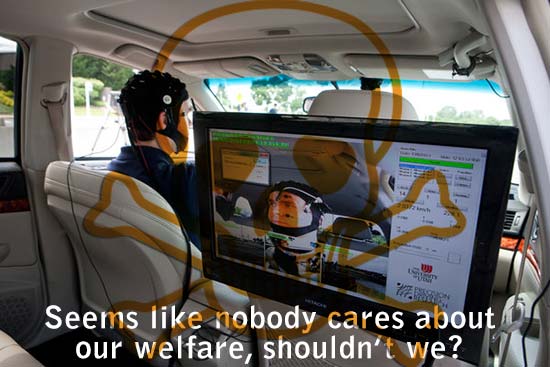Voice-Activated Technology Is Called Safety Risk for Drivers

- By MATT RICHTEL and BILL VLASIC - The New York Times - June 12, 2013
As concerns have intensified about driver distraction from electronic gadgets, automakers have increasingly introduced voice-activated systems that allow drivers to keep their hands on the wheel and eyes on the road. But a new study says that the most advanced of these systems actually create a different, and worse, safety risk, by taking a driver’s mind, if not eyes, off the road.
These systems let drivers use voice commands to dictate a text, send an e-mail and even update a Facebook page. Automakers say the systems not only address safety concerns, but also cater to consumers who increasingly want to stay connected on the Internet while driving.
“What we really have on our hands is a looming public safety crisis with the proliferation of these vehicles,” said Yolanda Cade, a spokeswoman for AAA, whose Foundation for Highway Safety released the study on Wednesday. She characterized the rush to equip cars with Internet-enabled systems as “an arms race.”
The study is among the most exhaustive look to date at the new in-car technology and sets up a potential clash between safety advocates and the auto industry, given that automakers increasingly see profit potential in the new systems.
In some high-end luxury cars, like the BMW 7-series sedan, drivers can dictate e-mails or text messages. And some mainstream models are equipped with options that can translate voice messages into text. The Chevrolet Sonic compact car, for example, has a system that allows drivers to compose texts verbally on an iPhone connected in the vehicle.
More than half of all new cars will integrate some type of voice recognition by 2019, according to the electronics consulting firm IMS Research. The auto companies argue that these systems are safer because they are hands-free.
“We are concerned about any study that suggests that hand-held phones are comparably risky to the hands-free systems we are putting in our vehicles,” said Gloria Bergquist, the vice president for public affairs at the Alliance of Automobile Manufacturers in Washington, adding that carmakers are trying to keep consumers connected without them having to use their hand-held phones while driving.
“It is a connected society, and people want to be connected in their car just as they are in their home or wherever they may be,” she said.
In April, the federal government recommended that automakers voluntarily limit the technology in their cars to keep drivers focused. The federal agency that made the recommendation, the National Highway Traffic Safety Administration, said it would review the latest research .
What makes the use of these speech-to-text systems so risky is that they create a significant cognitive distraction, the researchers found. The brain is so taxed interacting with the system that, even with hands on the wheel and eyes on the road, the driver’s reaction time and ability to process what is happening on the road are impaired.
The research was led by David Strayer, a neuroscientist at the University of Utah who for two decades has applied the principles of attention science to driver behavior. His research has showed, for example, that talking on a phone while driving creates the same level of crash risk as someone with a 0.08 blood-alcohol level, the legal level for intoxication across the country.
In this latest study, he and a team of researchers compared the impact on drivers of different activities, including listening to a book on tape or the radio, and talking on a hand-held phone or hands-free phone.
The researchers compared how the subjects performed when they were not driving with two other conditions: when using a driver simulator and in a car equipped with tools aimed at measuring how well they drove. The researchers used eye-scanning technology to see where driver attention was focused and also measured the electrical activity in the brain.
Mr. Strayer said the results were consistent across all the tests in finding that speech-to-text technology caused a higher level of cognitive distraction than any of the other activities. The research showed, for instance, that the person interacting with speech to text was less likely than in other activities to scan a crosswalk for pedestrians. And that driver showed lowered activity in networks of the brain associated with driving, indicating that those networks were impaired by the interaction with the technology.
Mr. Strayer said that the reason for the heavy load created by the technology was not totally clear. One reason appears to be the amount of effort required to talk to the dashboard, which is greater than talking to a person, who can interrupt and ask for clarification.
With a passenger or even on a phone, the other person says “wait, wait, I didn’t understand,” Mr. Strayer said. “That stuff is gone when you’re trying to compose an e-mail. You have to get your thought in order and lay it out in order.”
Mr. Strayer said the research should give automakers pause. “Look at new cars; they’re enabling sending e-mails, sending text, tweeting, updating Facebook, making movie or dinner reservations with voice commands,” he said. “The assumption is if you’re doing those things with speech-based technology, they’ll be safe. But they’re not.”
But the automakers are not likely to slow down development of the technology unless the law forbids it, said Ronald Montoya, consumer advice editor for Edmunds.com, a research firm.
“They’re not going to pause based on this research,” he said.


